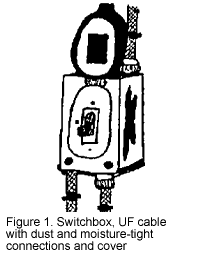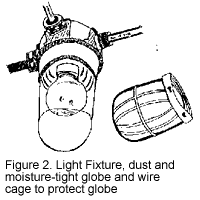Barn
fires are a farm owners worst nightmare. Most have tragic
results whether it is the loss of human life, an animal, valuable
equipment or the building structure itself. The majority of
all barn fires are the result of carelessness and a lack of
fire safety knowledge. Insurance statistics show that the
two most common times of the year for barn fires are summer
and winter. Summer fires are often the result of electrical
storms or spontaneous combustion of hot hay. Winter fires
are cause by appliances, rodents chewing through wires or
the accumulation of dust and cobwebs on electrical surfaces.
This fact sheet will explain to horse owners and others the
short and long term precautions that should be taken to help
reduce the incidence of barn fires.
Farm
owners and managers should be able to identify potential fire
hazards around the farm:
Highly
Flammable or Combustible Materials - If at all possible,
hay, straw and other types of bedding should not be stored
in the same building in which livestock is housed. Care should
be taken that these materials are not stored with machinery
or near any type of electrical or heat source. Highly flammable
materials may include:
- Hay
and straw
- Bedding
material (especially sawdust and shredded newspaper)
- Cobwebs,
dust, and grain dust
- Horse
blankets
- Paint
- Fertilizer
- Pesticides
and herbicides
Accelerants
- Accelerants are substances that increase the speed at which
a fire spreads. All accelerants are highly flammable or combustible,
but not all highly flammable or combustible materials are
accelerants. Accelerants must be stored in approved containers
and properly labeled as such (plastic milk bottles do not
quality as approved containers for storing chemicals). An
updated list of all chemicals on the farm should be maintained.
The list should include the name of the chemical, date purchased,
the quantity of the chemical, and the place of storage on
the farm. This list should be kept in a safe, handy place such
as a farm office (not in the building where the pro-ducts
are stored). In case of a fire, the list should be given to
the fireperson in charge to aid the fire department in knowing
what potential toxic fumes or explosions may result and how
best to contain the situation. Common accelerants include:
- Gasoline
- Kerosene
- Oil
- Aerosol
cans
Ignition
Sources - An ignition source is something that can cause
an accelerant or flammable material to ignite or smoulder.
Examples of ignition sources are:
- Cigarettes
and matches
- Sparks
from welding machines and machinery (trucks, tractors, mowers)
- Motors
- Heaters
- Electrical
appliances
- Fence
chargers
- Electrical
fixtures and wires
- Batteries
- Broken
glass
- Chemicals
which may react with each other or with water or dampness
When
constructing a new building in which to house horses and/or
livestock, precautions should be taken to reduce the chance
of barn fires. Many of these measures are required by the townships
building code. Always check with the town building inspectors
office for the requirements and permits necessary in your area.
Many
insurance companies will lower premiums if extra fire safety
precautions are taken during the construction of a new building,
some of which may be above and beyond the standards required
by the township. Check with industrial insurance companies
regarding which features will possibly lower insurance premiums.
Extra measures may include:
- Approved
Fire doors
- Fire
wall between hay/bedding storage and the actual stabling
area
- Use
of materials that are flame retardant or fire resistant
- Use
of fire retardant latex paint - preferably two coats
- Installation
of smoke detectors, fire alarm and sprinkler systems - all
of which can be monitored by local police or fire departments.
Early fire detection systems may give you enough time to
get livestock out and maybe save the building.
- Trickle-charged
battery powered emergency lighting to permit evacuation
of people and animals in case of power failure.
- A
water source on the premises, especially a pond will help
the fire department to save buildings. Trucking in water
from a distance if a water hydrant is not available is time
consuming. Remember to have the water source properly fenced
to keep unwanted visitors out.

Electrical systems in barns, especially in older structures,
is often the cause of a barn fire. The following safety precautions
(sometimes beyond the township electrical code requirements)
should be taken when installing a new system or repair of an
older electrical system.
- Avoid
areas of excessive moisture for the location of the main
electrical panel box.
- Place
panel box in the driest, most dust free area as possible.
(Stall areas are not recommended; place in tack room or
utility room.)
- Panel
box should be corrosive resistant and weather-proofed even
if installed inside a building.
- Outlets
and switch boxes should be made of metal and have dust and
water tight spring-loaded covers that close when released
(See Figure 1).
- Wires
should be encased in metal conduit pipe. Even temporary
wires (such as extension cords to a tank heater) should
be run through conduit pipe to keep the wires safe from
breakage and away from the teeth of horses, livestock and
rodents and metal shoes of horses.
- Light
fixtures for fluorescent lights should have dust and moisture
resistant covers. Incandescent bulbs should have gloves
with seals that are dust and moisture proof, surrounded
by a globe cage to prevent accidental breakage (See Figure
2).
Below
is a check list regarding other electrical concerns in animal
facilities.
- Motors
- such as the type used for circulation fans, water pumps
or hay elevators should have moisture/dust proof on/off
switches.
- Motors
should not be within 18 inches of any combustible material
(hay, bedding). A fire resistant shield should be placed
around such material to protect it from any heat given off
by a motor.
- Electric
fence units can be potential fire hazards, especially if
the units are of the continuous currnt type. Use only UL
listed units that are of the solid state transistor-type,
with intermittent current. Fence-line units should be 10
feet from buildings, enclosed in a weather-proof structure.

- Any
appliances used in the barn (i.e. clippers, dryers, vacuums)
should be UL approved and grounded. Appliances with broken,
frayed cords or bent plugs should not be used until properly
repaired. (Wrapping the cord in electrical tape is not a
proper method of repairing a frayed cord.) All appliances
should be disconnected when not in use.
- Portable
heaters should not be used in the barn area. If they are
used in tack rooms, heater units should not be left unattended
and turned off when you leave the room. Many of these heaters
do not contain safety devices which prevent overheating.
- Do
not place portable space heaters near live-stock where they
may be knocked over. Make sure heaters have a shut-off device
that activates if the unit is knocked over.
- Improperly
utilized heat lamps are a major source of barn fires. They
are often placed too close to hay and bedding which may
ignite quite easily from the heat. Never use extension cords
with heat lamps.
- Heat
tapes and water tank heaters must have a thermostat and
be UL listed. Tapes and tank heaters should be installed
and used following manufacturer instructions. Tank heater
cords and heat tapes should be adequately protected so that
animals (horses, livestock, cats, dogs, rodents) cannot
easily chew through them causing electrocution, electrical
shocks or a barn fire. Heat tapes should be protected with
a fire retardant insulation material.
- Smoking
should never be permitted in any barn, hay/bedding storage
area, tack room or lounge. No-Smoking signs should be posted
in these areas and at all exterior entrances. Butt cans
provided as an incentive to extinguish all cigarettes.
- Exit
doors should be clearly marked.
- Aisles
should be raked or swept clean of hay and bedding. Vacuum
up cobwebs and dust regularly. Wipe dust/dirt off light
fixtures, outlet covers, switches and panel boxes (see Figure
1).
- Weeds,
twigs, and other trash should be kept mowed or picked up
from around the outside of the barn.
- Manure
piles should be at least 20 feet away from the barn to reduce
the chance of combustion fire.
- Hay/bedding
storage should not be near lights, fans, electrical boxes,
heaters or outlets.
- When
storing newly baled hay, care should be taken that the temperature
of the bales does not get too hot. Adequate ventilation
should be provided for additional drying of the hay. If
too much heat builds up, spontaneous combustion is inevitable.
(Never purchase hay that is hot - meaning that it was baled
too wet. This is a fire hazard and the hay will usually
turn moldy, making it unpalatable and unhealthy for horses
to eat.)
- Flammable
substances should be kept elsewhere besides the barn.
- Store
vehicles and machinery in a separate building.
- A
halter and lead shank for each horse should be hung on all
stall door fronts in case of an emergency.
- A
fire hose and buckets should be available and kept for this
purpose only.
- Practice
fire drills should be held so employees and boarders are
familiar with their responsibilities should a real fire
occur.
- Buildings
should be equipped with professionally installed lightning
rods of copper or aluminum. The system should be properly
grounded.
- All
pipes, water systems, electrical systems and telephone lines
should also be grounded.
- Contact
a professional company for proper maintenance and installation.
Fire
Extinguisher
- ABC
(all class) dry-chemical fire extinguisher should be in
all livestock buildings, workshops or wherever welding is
done.
- The
extinguisher should be of 5 lb. minimum; 10 lb. is ideal.
- Even
if a unit is only partially discharged, the extinguisher
must be recharged.
- A
fire extinguisher should be hanging at all exterior doorways,
in the middle of long aisles, and next to the electrical
panel box.
- Signs
denoting placement of fire extinguisher should be highly
visible.
Remember,
the barn can be a safe place for horses and/or livestock to
live and for you to enjoy if you follow the above recommended
fire safety procedures and precautions.
- Basic
Horse Safety Manual. American Youth Horse Council in
Cooperation with American Horse Council. 1989.
- Extinguishing
Fire Hazards. Equus Magazine, 162. April 1991.
- Fire
Safety in Agricultural Buildings. Reinsurance Association
of Minnesota. 1983.
Publication #: FS608
This
document is apart of
a series from the Rutgers Cooperative Extension, Rutgers, the
State University of New Jersey. Publication date: February
1992.
Marjorie
R. Margentino, Program Associate in Animal Science, and Karyn
Malinowski, Ph.D., Extension Equine Specialist. Rutgers cooperative
Extension, Rutgers, The State University of New Jersey, New
Brunswick, NJ 08903
Disclaimer and Reproduction Information: Information in
NASD does not represent NIOSH policy. Information included in
NASD appears by permission of the author and/or copyright holder.
More
 Electrical systems in barns, especially in older structures,
is often the cause of a barn fire. The following safety precautions
(sometimes beyond the township electrical code requirements)
should be taken when installing a new system or repair of an
older electrical system.
Electrical systems in barns, especially in older structures,
is often the cause of a barn fire. The following safety precautions
(sometimes beyond the township electrical code requirements)
should be taken when installing a new system or repair of an
older electrical system.
